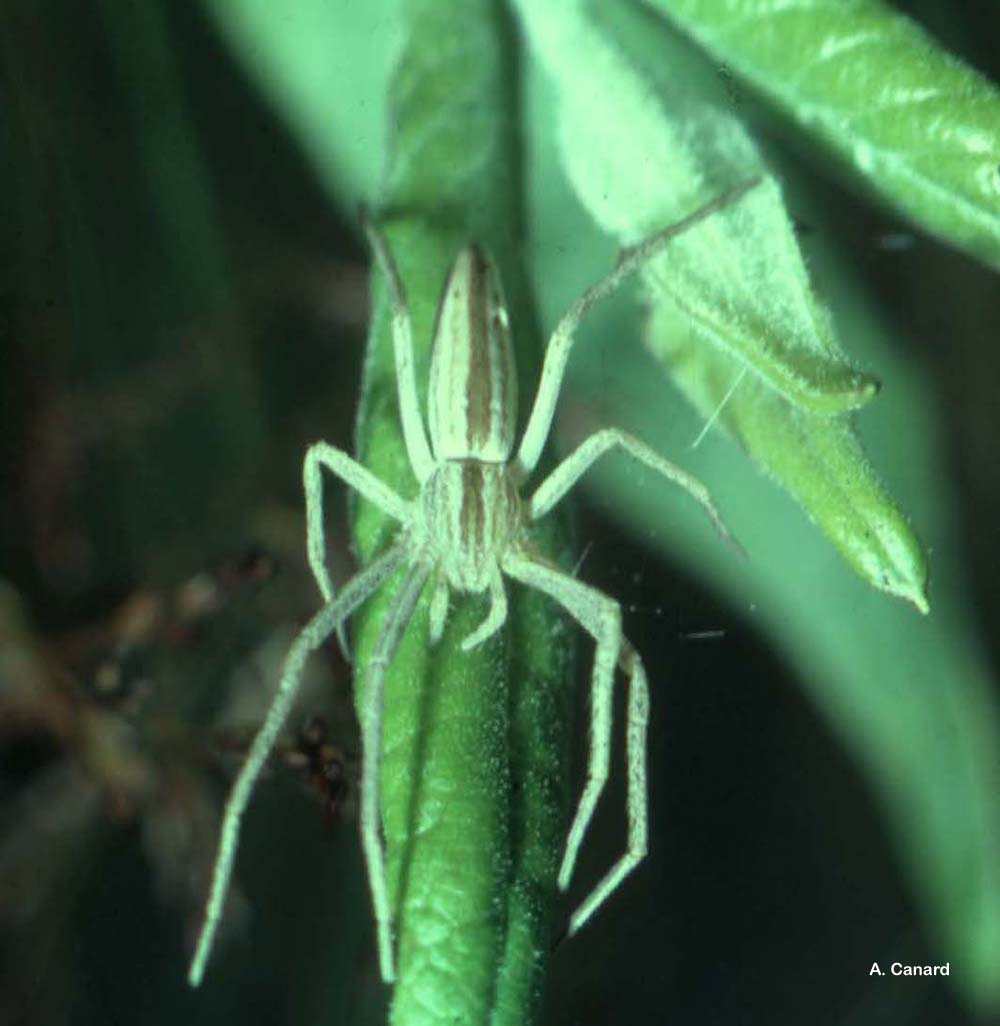
cd_nom

| Author : A. Canard |
 |
To get the picture, please visit:
Alain Canard
Biodiversité et gestion des territoires
Université de Rennes 1
SPN, Av du Gal leclerc
30042 Rennes Cedex
email: alain.canard@univ-rennes1.fr
Legend: femelle, La Mézière
Any reuse of one or more photographs on this site is subject to an authorization request from the author.
Link to the Code of Intellectual Property (Legifrance)

| Author : G. Bourderionnet / INPN |
 |
To get the picture, please visit:
Guy Bourderionnet
inpn@mnhn.fr
Despite the Creative Commons license, please inform the author of the use which will be made of his photo
Distribution mondiale
toute l'Europe, Moyen-Orient
Caractères distinctifs, espèces
Taille - femelle : 7-11 mm, mâle : 6-8 mm.
Espèce aux longues pattes avec un corps très allongé, jaune-grisâtre. Le céphalothorax et l'abdomen présentent une bande médiane longitudinale brune plus sombre. De chaque côté de cette bande il existe une série plus ou moins nette de petits points dont un des derniers est assez gros et bien visible. Il y a six espèces de Tibellus et Paratibellus en France, deux d'entre elles, les plus communes, ont souvent été confondues : T. oblongus et T. maritimus. Leurs colorations respectives sont un peu différentes et la série de points latéraux sur l'abdomen est assez continue et homogène chez T. maritimus alors qu'elle est plus limitée à l'avant chez T. oblongus. Ici aussi, la meilleure certitude pour l'identification viendra de l'observation des pièces génitales.
Milieux colonisés
Colonise divers milieux ensoleillés dont la végétation est formée de grandes graminées : oyats des dunes littorales, molinies des milieux humides, et aussi bromes des causses en milieux assez secs.
Chasse
Si les individus sont en constants déplacements, ils effectuent des affûts périodiques. La position du corps le long d'une tige de graminée, avec les pattes allongées, rend l'espèce très difficile à discerner, comme peuvent l'être les Tétragnathes. Lorsqu'une proie est repérée, elle est approchée et saisie après un bond.
Développement, cycle
Les mâles sont présents de mai à juillet, les femelles de mai à septembre. Le cycle est annuel, il pourrait avoir lieu sur deux ans pour certains individus. La femelle pond un cocon de 50 à plus de 100 œufs qu'elle tisse en général sur la végétation, en position élevée. La femelle reste sur la ponte jusqu'à la sortie des jeunes.
A. Canard(Université de Rennes/Service du Patrimoine Naturel, MNHN),2014
Continental
Metropolitan France
Overseas
Marine
Metropolitan France
Overseas
The map presents a summary at the 10 x 10 km grid of the observation data for the species transmitted to the SINP. These data have been subjected to validation filters.
The map presents a reference distribution layer of the species at the scale of departments and marine sectors. The presence and absence data were established by expertise within a network of partners. This reference distribution is used in the validation process of the SINP data at the INPN level.
Corresponds to a report on the basis of at least one observation proved within a period of 10 years (20 years for little-known invertebrates) preceding the year and no presumption of extinction since obtaining the last data nor doubt on reproductive and implemented nature of this population. For migratory species, the presence indicated concerns areas of reproduction.
This status is based on one or more of the following criteria:
This point covers the absence, more difficult by nature to demonstrate than presence. This status is based on one or more of the following criteria:
This status must be assigned to a department in which the presence of the species is casual.
Particular case of absence due to a proven extinction less than a half century ago (older disappearances are treated as "no probable or definite").
In the state of knowledge, we can not comment on the presence or absence in the current department. This is the default status when not comprised in one of the previous categories or whenever there is doubt.
The map shows the global distribution of the species based on GBIF data (Global Biodiversity Information Facility).
